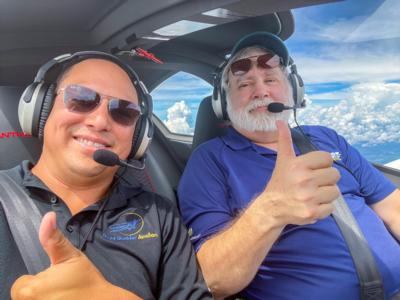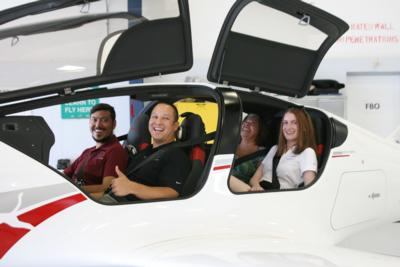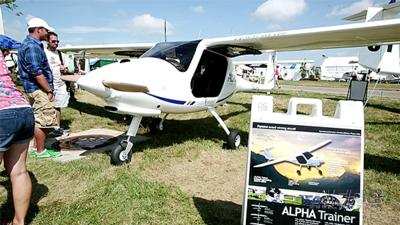By Jim Campbell, ANN CEO/Editor-in-Chief/Test Pilot (Arrogant, Over-Opinionated Know-It-All/Test Dummy)
ANN E-I-C Note: It’s been a while since I had the chance to sit down and do a flight test report the way that I want to… at least as far as the flight dynamics and writing are concerned. ANN is simply too time-consuming to allow for much in the way of 'extra' projects right now, as we recover from all the added issues that the pandemic has dumped on us.

I’ve looked forward to this one a great deal... and it appears that the wait was worth it… In the next 5 (possibly six) parts of this 8000 word magnum opus, we will lay out ALL the nitty-gritty of our flight test and analysis of the Pipistrel Panthera… as well as a few other issues… like the rant that precedes Part One. These things are LOT of work… it takes days to go through the notes, coordinate that with the analysis, stats, and specifications… and then make sure it doesn’t read like an FAA manual. We’ll drop a new part every few days as each of them passes muster, and emerges whole from the editing process (though there may be more rants in the future... YOU have been warned). I hope we get to do much more of these going forward, as well as adding new features to our video coverage of such stories... we have some exciting ideas and I think you'll like what we have in mind.
RANT ALERT: Before we get into the parameters of a flight test that I’ve been looking forward to for a considerable period of time, let me get a few things off my chest.

I take a great deal of pride in the amount of detail we present, and the standards we’ve applied to conducting our flight tests. That’s why these things don’t come that often, and are an incredible amount of work to produce. More important; the standards by which these programs may be conducted are changing by the day, because we now have a lot more tools at our disposal to bring the realities of flight test and evaluation to the public in a manner in which they cannot only read what’s being done, but see and hear those standards that are being applied.
I’m tremendously excited by the possibilities… But at the same time, some of the atrocious garbage that has shown up on YouTube and other venues that are attempting to disguise themselves as flight tests or flight reports or flight reviews or other misleading terms, are often riddled with error and guesswork -- or at worst, just downright wrong -- and at best, they’re a lot of superfluous fluff. The fluff pieces may not be all that adversely dangerous, per se, but they sure can mislead people into believing things that are not supported by the requisite combination of expertise and properly substantiated data.
Mind you; I DO have a little bit of what some might call an arrogant attitude about the skills I’ve acquired, and the standards I apply… But then again if you’ve ever met a truly accomplished test pilot, you can rarely miss the ‘assurance/ego’ that comes with them. And frankly, that’s an earned attitude (often called the ‘Yeager Effect’). When you put a lot of work into something, when you meet exacting standards, and when you WON’T compromise them; there is a sense of accomplishment and confidence that comes with it. And yeah, sometimes it puts a few people off, but in no uncertain terms (and far worse), I hate what I’m seeing right now on YouTube where some instant expert can tout a flight test while flying in an airplane from the backseat, and for which he or she is not even rated, or where people compile lists of the best aircraft in a number of categories, when in fact they not only haven’t flown those airplanes (and are often
stealing the video B-Roll off of other YouTube sites), but in many cases, the airplanes no longer exist for sale to the public, so such errant judgments are worthless and (again) misleading.

These things are rarely disclosed in the course of the so-called program, and while some of the people conducting these so-called reviews have managed to put together some pretty solid video skills, and may have a good gift of gab, a lot of what I see these days is complete and utter drivel—and might even be dangerously misleading. A worrisome percentage of such programs seem that way, these days, as a matter of fact.
So… We try to set some pretty high standards for the future, and more importantly, for our own conduct. And while we can’t apply all of them right this minute (our people are based all over the country and some are not currently free to travel in support of such programming due to travel and other restrictions), do understand that the initial flight test experience we had with the Pipistrel Panthera was conducted according to proper, expert, test pilot protocols and standards, the data was recorded and reviewed with the other pilot on board (RRA’s Andy Chan) the aircraft for fact-checking and accuracy, and the report that follows is a fairly detailed analysis of what this airplane is, and what it can do.
I’m working with one of the best videographers in the industry, ANN’s Nathan Cremisino, right now to update and put together a much better standard that will not only allow me to do these exhaustive written flight tests in the long run, but will allow us to produce better video flight test portrayals of what actually happens in the aircraft, what we experience, how we measure it, and the standards we’re applying.
This is important, folks. The last couple times I’ve seen so-called flight reviews, I’ve seen inane descriptions of stability and control profiles -- if in fact they are even described at all. I’ve seen people parrot what the demo pilot is saying to them without doing any questioning, investigation or verification. I see few, if any, measurements and standards applied to the flight tests that would explain some of the results that are being (often) poorly documented or described… I.e. an airplane at sea level performs a whole hell of a lot different than the aircraft departing from some place with a very high density altitude – details which MUST be provided… along with many others. The conditions under which the aircraft is flown... weight, equipment, configuration, and so much more means a lot to the final evaluation of the aircraft and how the aircraft REALLY performs and handles.
So… Please read ahead and understand that this is a solid analysis of an initial test flight on the Pipistrel Panthera, it is not by any means complete, since we will go back and re-fly the aircraft along with our video and audio equipment set up and in accordance with a series of procedures that we will institute in order to make sure that what we do can be seen and heard and understood by people in the future, and also make for an entertaining, educational, and informative production for folks that are looking to lay down serious cash for the airplane of their dreams.

The one thing we want to make sure is this… That what we tell you is the God’s honest truth, and is the real skinny.
And that you really won’t find a whole hell of a lot of THAT on YouTube -- For Now.
Yes, do note that there are a few folks on YouTube who do, unquestionably, know what they’re talking about (The Patey Brothers come to mind, among a few)… Some of those reports are very aircraft specific, and a few of them are pretty damned good. Still; they are the minority, and I promise you that when we come across those people doing that kind of good work, we will point it out.
Honest.

FINALLY -- On to the flying biiz... Aero–News was privileged to be the first to fly a US registered Panthera, as it came pretty much straight out of the crate a few days before, from Pipistrel HQ, in Slovenia. Unfortunately, we did not have a whole lot of prep time, but nonetheless elected to head down to very sunny, very warm, Inverness, Florida, the home of Right Rudder Aviation -- who will be serving as the US distributor for the aircraft, in order to at least get an initial flight test done. And yes, I really wanted to fly this thing… bad.
Under normal circumstances, I’d have first had a chance to look through a POH, put together some test cards after a quick conversations or two with the folks involved with the airplane, and set up a shooting and interview schedule with my videographer. Because of the issues around travel right now, as well as the short notice, none of that really got done this time around. However; since the interest in this aircraft is so high, and because a first look is great demand, and we were privileged to be able to get in at the head of the line, so that we are now pleased to present the initial findings.

As previously noted, the first US registered Pipistrel Panthera is based in Inverness Florida at the home of Right Rudder Aviation. The operation is pretty much the brainchild of Andy Chan and a very talented staff. Andy has built himself a really nice little operation here… In that he is the airport FBO, he is the aircraft fuel farm, and of course he’s the flight school. Right Rudder Aviation is a small but growing flight school that has been utilizing a number of aircraft, though principally concentrating on the Pipistrel Alpha in a motor glider configuration. This has allowed them to put out attractive, modern, training aircraft at very cost-effective rates. One of the things that Right Rudder has been extremely smart about, has been looking for niches that will attract students. And right off the bat they put together a Private Pilot – Glider training course that includes 10 hours in the airplane, all the appropriate instruction, the checkride and a number of
incidentals for the total price of $2995. Keep in mind that you can get a PPG with as little as 10 hours total time… And while many people are unlikely to do that in as little as 10 hours; the last two students in the program both accomplished their PPG in (respectively) 10.3 hours and 13 hours. Of course, if you go over the 10-hour period, you pay the appropriate hourly rate to get you to the point of being able to take the checkride.
It’s a brilliant incentive and the phones are ringing off the hooks (be sure to call ASAP to avoid getting stuck on a waiting list). RRA apparently doesn’t hire dummies, and isn’t run by them, either. Better yet, the managing organization for Pipistrel's operation in North America (Pipistrel USA), based on years of observation, is just as much a class act.
NEXT: Part Two… we finally get to the REAL airplane stuff and quit the sermonizing… specs, descriptions, and analysis of the aircraft’s systems, attributes, and basic operations are described and analyzed, and we get ready to get this beast off the ground and see how fast it REALLY is.
 ANN's Daily Aero-Term (04.20.24): Light Gun
ANN's Daily Aero-Term (04.20.24): Light Gun Aero-News: Quote of the Day (04.20.24)
Aero-News: Quote of the Day (04.20.24) ANN's Daily Aero-Linx (04.21.24)
ANN's Daily Aero-Linx (04.21.24) Aero-News: Quote of the Day (04.21.24)
Aero-News: Quote of the Day (04.21.24) ANN's Daily Aero-Term (04.21.24): Aircraft Conflict
ANN's Daily Aero-Term (04.21.24): Aircraft Conflict








